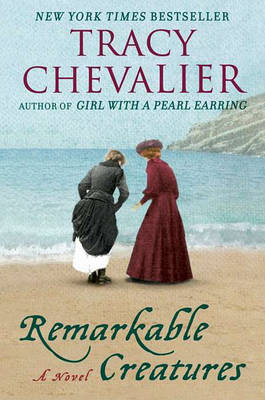Reviewed by brokentune on
Many thanks to Autumn for introducing me to this alternative version of Harry Potter.
I am kidding, of course, but the thought of Mary Anning as a real-life HP using fossils as portkeys to be transported into a time so different that it might as well just be another world did appeal to me for quite some time.
Tracy Chevalier (author of Girl with a Pearl Earring) created a fictional account of the friendship of two women who not only existed in real life but who also changed natural history as we know it. And all this decades before Charles Darwin would publish that little known tome about the the origin of species.
So, who, I hear you ask, are the two women?
Well, the first one is Mary Anning, whom the Natural History Museum introduces as follows:
"The greatest fossil hunter ever known was a woman from Lyme Regis. Mary Anning's discoveries were some of the most significant geological finds of all time. They provided evidence that was central to the development of new ideas about the history of the Earth.
Mary Anning’s contribution had a major impact at a time when there was little to challenge the biblical interpretation of the story of creation and of the flood. The spectacular marine reptiles that Anning unearthed shook the scientific community into looking at different explanations for changes in the natural world. William Buckland, Henry de la Beche and William Conybeare were some of the many scientists who owe their achievements to her. By the time of her death, geology was firmly established as its own scientific discipline."
Not a bad feat for a woman who was a contemporary of Jane Austen's at a time when women were not allowed to contribute to scientific journals or indeed even enter the clubs and societies that were available for the scientifically minded.
What is even more astonishing is that Mary Anning had little education and spent most of her early years in abject poverty.
The second woman is Anning's friend, Elizabeth Philpot, an educated woman who, being a spinster, relocated with her sisters to Lyme Regis after the death of their father. In fact, reading her story strongly reminded me of the sisters in Sense and Sensibility - and yes there even is a military man who plays a crucial role in the lives of both women.
Anyway, spurned by the move to Lyme Regis, Elizabeth becomes a fossil collector, too, and befriends Mary.
"How can a twenty-five-year-old middle-class lady think of friendship with a young working girl? Yet even then, there was something about her that drew me in. We shared an interest in fossils, of course, but it was more than that . Even when she was just a girl, Mary led with her eyes, and I wanted to learn how to do so myself."
The story that Chevalier creates of the friendship of the two women is truly magnificent. The difference in age and class causes many obstacles for women to communicate and there are major rifts between them, which left me wondering how they would cope, how they would resolve their differences. And in the end, whether they would manage to be able to rely on each other when everything they had worked for was put at risk and depended on their friendship.
"I had discovered from conversations I’d had about fossils with the people of Lyme that few wanted to delve into unknown territory, preferring to hold on to their superstitions and leave unanswerable questions to God’s will rather than find a reasonable explanation that might challenge previous thinking. Hence they would rather call this animal a crocodile than consider the alternative: that it was the body of a creature that no longer existed in the world. This idea was too radical for most to contemplate. Even I, who considered myself open-minded, was a little shocked to be thinking it, for it implied that God did not plan out what He would do with all of the animals He created. If He was willing to sit back and let creatures die out, what did that mean for us? Were we going to die out too?"
Review first posted at http://brokentune.booklikes.com/post/1128421/remarkable-creatures
Reading updates
- Started reading
- 14 March, 2015: Finished reading
- 14 March, 2015: Reviewed
